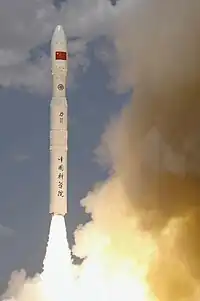CAS Space
CAS Space (Guangzhou Zhongke Aerospace Exploration Technology Co., Ltd.) is a Chinese commercial space launch enterprise founded in 2018 of mixed ownership, partially owned by the Chinese Academy of Sciences.[1][2] Originally started in Beijing, the enterprise is now headquartered in Guangzhou, China, while its Beijing location continues to be its primary R&D center. The enterprise has constructed its dedicated launch pad and facilities at JSLC.[2] The launch pad is considered the first launch pad in China built for commercial use. The enterprise has multiple subsidiaries including a Guangzhou-based company responsible for the operation of its aerospace technology & industry base and a Xi'an-based propulsion system company.[2] The enterprise is purposed to materialize research projects from Chinese Academy of Sciences and is dedicated to space exploration, research and to be a launch service provider. The enterprise is currently developing the Kinetica (力箭) rocket family.
| CAS Space | |
Native name | 广州中科宇航探索技术有限公司 |
| Industry | Launch service provider |
| Founded | April 2018 in Beijing, China |
| Headquarters | Guangzhou, Guangdong, China |
| Website | www |
The enterprise has a motto of "Go above and beyond", or "无畏向上 无限可能" as it is publicized in Chinese.[2]
Rockets
Kinetica 1

The company's first solid-fuel launch vehicle Kinetica 1 (Lijian-1, PR-1)[3][4] is 30 m (98 ft) tall, 2.65 m (8 ft 8 in) in diameter and weighs 135 t (149 tons). It consists of four all solid fuel stages. The Kinetica 1 is capable of lifting 1.5 t (1.65 tons) to SSO at an altitude of 500 km or 2 t (2.20 tons) to LEO.[5][6]
CAS Space conducted ground tests for the four-stage Kinetica 1 in November 2021.[7] Its maiden flight was conducted on 27 July 2022, sending 6 satellites into SSO.[8] It is currently the largest solid-fueled rocket in China.
| Flight number | Serial number | Date (UTC) | Launch site | Payload | Orbit | Result |
|---|---|---|---|---|---|---|
| 1 | Y1 | 27 July 2022 04:12 |
LA-4, JSLC | SATech 01 Dianci Zuzhuang Shiyan × 2 GNSS-R Jinan-1 Nanyue Science Satellite |
SSO | Success |
| 2 | Y2 | 7 June 2023 04:10 |
LA-4, JSLC | Shiyan 24A/B Fucheng-1 Xi'an Hangtou-8 CXPD 21 undisclosed satellites |
SSO | Success |
| 3 | Y3 | Q3 2023 | LA-4, JSLC | TBA | TBA | Planned |
| 4 | Y4 | Q4 2023 | LA-4, JSLC | TBA | TBA | Planned |
Kinetica 1A, 2, 3, 3H
The enterprise has presented a roadmap including a medium-lift launch vehicle Kinetica 1A (scheduled to enter service in 2022), a small-lift liquid-fueled reusable vehicle Kinetica 2, a medium-lift reusable vehicle Kinetica 3 with its heavier variant Kinetica 3H (2 boosters added), and a sub-orbital experimental vehicle Near-space Experimental Reusable Platform (NEXT-REP).[2]
Space Tourism Vehicle
In August 2021, it was announced that CAS Space was developing a single stage sub-orbital space tourism vehicle which is very similar to Blue Origin's New Shepard rocket. The vehicle, composed of a booster and capsule, would be powered by five Xuanyuan engines. An uncrewed demonstration flight is expected to occur in 2022, then a full-fledged uncrewed suborbital flight in 2023, with tourism service to start in 2024.[9][10] The vehicle under development is designated ZK-6.[2]
References
- "Launch of powerful new carrier rocket expected in 2022". english.www.gov.cn.
- "关于我们 - 中科宇航". www.cas-space.com. Retrieved 2022-07-25.
- "CAS SPACE". en.cas-space.com. Retrieved 2023-03-01.
- "China aims to complete space station in another huge year in space". 3 January 2022.
- "产品信息 - 中科宇航". www.cas-space.com. Retrieved 2022-07-25.
- "Guangzhou moves to establish Chinese commercial space cluster". SpaceNews. April 6, 2021.
- "China is developing new solid rockets to boost overall space capabilities". SpaceNews. March 18, 2022.
- "一箭6星!力箭一号运载火箭首飞成功-新华网". www.news.cn. Retrieved 2022-07-27.
- Andrew Jones published (2021-10-04). "Chinese company aims for suborbital space tourism with familiar rocket design". Space.com. Retrieved 2022-06-07.
- "A Chinese New Shepard? CAS Space Eyes Space Tourism - Dongfang Hour". 2021-09-02. Retrieved 2022-06-07.
